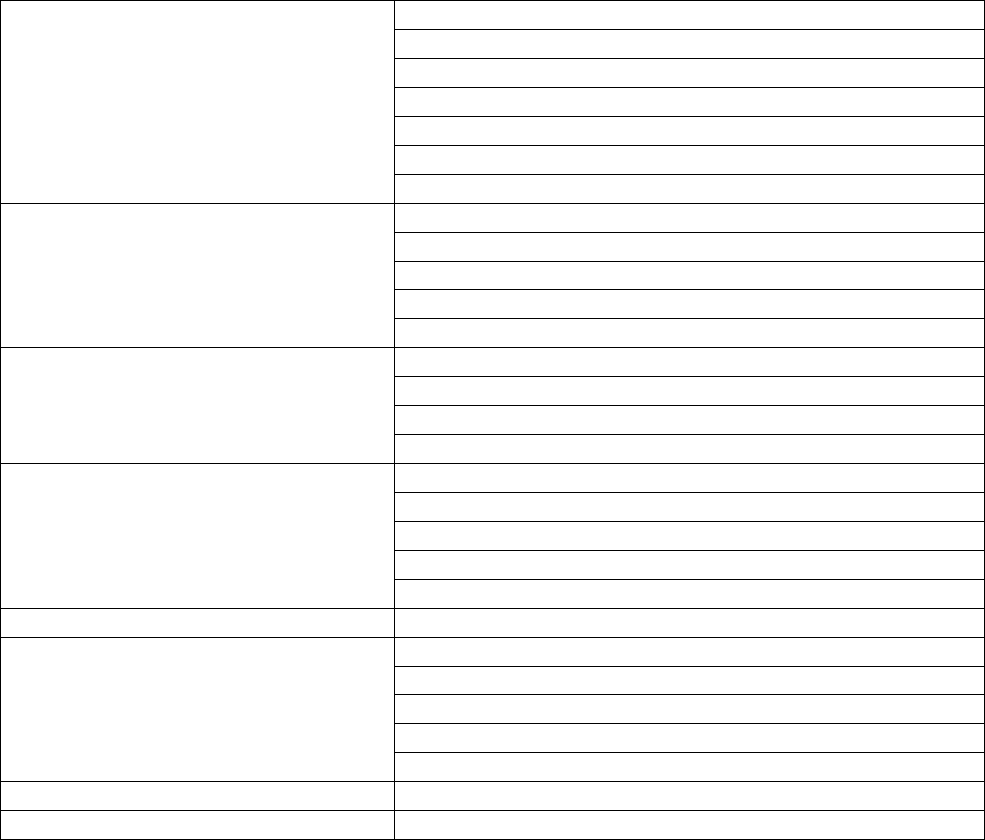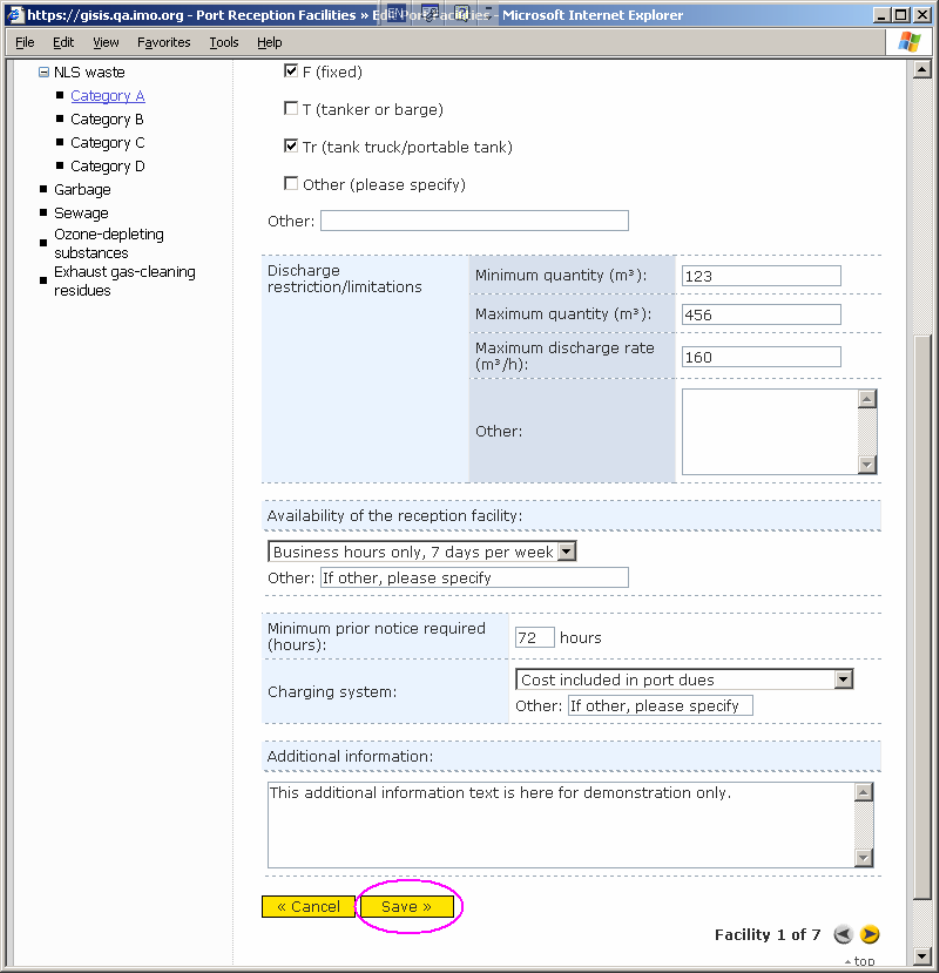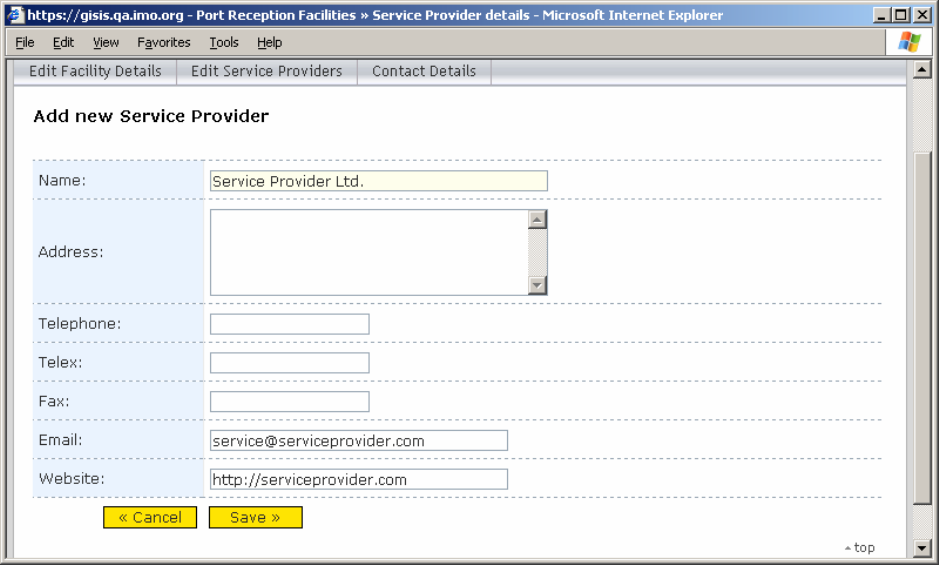
I:\C_L\2683.doc
INTERNATIONAL MARITIME ORGANIZATION
4 ALBERT EMBANKMENT
LONDON SE1 7SR
Telephone: 020 7587 3152
Fax: 020 7587 3210
IMO
E
Ref. T/16 Circular letter No.2683
30 November 2005
To: All IMO Member States
Subject: Global Integrated Shipping Information System (GISIS) – port reception
facilities database
1 As suggested by FSI 13 and approved by MEPC 53, the Secretariat has developed an
Internet-based port reception facility database (PRFD) as a module of the IMO Global Integrated
Shipping Information System (GISIS), with the aim of facilitating global access to information on
port reception facilities around the world and promoting the exchange and accuracy of that data.
2 Information on the GISIS system, including the Manual for Member States’ Administrations,
has been communicated to Member States by means of Circular letter No.2639 dated 8 July 2005.
Information provided by the PRFD
3 The PRFD provides information on the available port reception facilities for the delivery of
the following categories of ship-generated waste:
.1 Oily waste (oily bilge water, oily residues (sludge), oily tank washings (slops), dirty
ballast water, scale and sludge from tank cleaning, and oily mixtures containing
chemicals;
.2 NLS waste (Categories A, B, C and D;
.3 Garbage;
.4 Sewage;
.5 Ozone-depleting substances and equipment containing such substances; and
.6 Exhaust gas-cleaning residues.
4 For each one of the above waste categories the information set out at annex 1 would be
provided in the database.
5 The PRFD also contains information regarding:
- the procedure for reporting alleged inadequacies of port reception facilities, including
a copy of the consolidated reporting format (MEPC/Circ.469);
- the contact details of the national Authorities responsible for handling reports on
alleged inadequacies of reception facilities, including their e-mail addresses; and

Circular letter No.2683 - 2 -
I:\C_L\2683.doc
- cases of alleged inadequacies of port reception facilities reported to IMO and the
follow-up response by the port States.
PRFD design
6 The PRFD has been designed to allow the competent authorities of the Member States to
update the database by introducing new entries, editing or deleting existing records pertaining to port
facilities operating under their jurisdiction. Access to this interactive function of the database is
strictly via a log-in password provided to Member States, to ensure authentication of the information
contained in the PRFD (Circular letter No.2639).
7 The PRFD will be available to the general public through the GISIS web-page on a view-only
basis for 24 hours a day with the possibility of searching the database and retrieving information on
the available reception facilities per country, port and specific type of waste(s).
Data already populated in the database
8 The PRFD has already been populated by the IMO Secretariat with data on port reception
facilities for the reception of oily waste and noxious liquid substances by using the available data
contained in MEPC.3/Circ.4 and MEPC.4/Circ.5 circulars respectively. However, in some cases the
data contained in the aforementioned circulars were not fully compatible with the layout of the
PRFD and the Secretariat had to make a number of adjustments. Therefore, these data should be
carefully reviewed and validated by the Member States.
Action requested of Member States
9 Prior to the database being made available to the general public, Member States are invited to:
.1 review the existing data on port reception facilities for the reception of oily waste and
noxious liquid substances contained in the database, with the aim of checking their
accuracy, amending them as necessary and including any additional available data;
.2 populate the database with initial information on port reception facilities for the
delivery of garbage, sewage, ozone-depleting substances and equipment containing
such substances, and exhaust gas-cleaning residues; and
.3 provide the contact details of the national Authorities responsible for handling reports
on alleged inadequacies of reception facilities.
10 In order to allow this exercise to be conducted in a smooth and efficient manner, a timeframe
of three months will be allocated for this process. At the end of this trial period (1 March 2006) the
database will go live to the public. If during the trial period Member States should encounter any
problems whilst inputting the information, they should contact IMO at e-mail address:
[email protected] or by fax +44 20 7 587 32 10.
11 Brief instructions on how to manage the data in the PRFD via the GISIS website are attached
at annex 2.
***

Circular letter No.2683
I:\C_L\2683.doc
ANNEX 1
INFORMATION ON AVAILABLE PORT RECEPTION FACILITIES
The following information should be provided, as appropriate, in the database for each port of each
Member State:
Name
Address
Telephone
Telex
Fax
E-mail
Service provider
Website
Select one or more from:
F (fixed)
T (tanker or barge)
Tr (tank truck/portable tank)
Type of facility
Other (specify)
Minimum quantity (m
3
)
Maximum quantity (m
3
)
Maximum discharge rate (m
3
/h)
Discharge restriction/or limitations
Other (specify)
24 hours a day, 7 days per week
24 hours a day, 5 days per week
Business hours only, 7 days per week
Business hours only, 5 days per week
Availability of the reception facility
Other (specify)
Minimum prior notice required
(hours)
Select one from:
Free-of-charge
Cost included in port dues
Cost charged in addition to other services
Charging system
Other (specify)
Additional information
(free text)
Last updated
(date)
***

Circular letter No.2683
I:\C_L\2683.doc
ANNEX 2
BRIEF INSTRUCTIONS ON HOW TO MANAGE THE DATA IN THE PRFD
Member State Access to the GISIS Port Reception Facilities (PRF) Module
As part of the integrated GISIS system, access to the PRF module is via the GISIS Members’
website at https://gisis.imo.org/Members.
The national Administrator for GISIS accounts is required to create user accounts with the
appropriate privilege for accessing the PRF module. (The User Administration Manual for creating
accounts and granting privileges is provided in Circular letter No.2639.)
The following screenshot illustrates an example of a user account. Upon logging into the
GISIS Members’ Area, the user with the appropriate privilege for accessing the PRF data will
encounter the welcome screen as shown below:

Circular Letter No.2683
ANNEX 2
Page 2
I:\C_L\2683.doc
Reviewing existing data
Member States are requested to check the baseline data entered by the Secretariat on port reception
facilities for the reception of oily waste and noxious liquid substances.
To check the facilities at each port, first click on Edit Facility Details on the top menu. Then select
the port from the list, and click the button below:

Circular letter No.2683
ANNEX 2
Page 3
I:\C_L\2683.doc
Select a waste category from the menu on the left to see reception facilities for that category.
Use the paging buttons to scroll through multiple facilities for one waste category:
To edit the details of a facility, click on the Edit button. Click Delete to delete the waste facility
entry.

Circular Letter No.2683
ANNEX 2
Page 4
I:\C_L\2683.doc
Once details have been updated, click the Save button at the bottom of the page. Click Cancel to
abandon your changes.

Circular letter No.2683
ANNEX 2
Page 5
I:\C_L\2683.doc
Populating the PRF module with new data
To enter details of new port reception facilities in the database, follow the instructions in the
previous section to Edit facility details of a port, and select the relevant waste category from the
left. Then click Add new facility:

Circular Letter No.2683
ANNEX 2
Page 6
I:\C_L\2683.doc
When adding a new facility, a Service Provider must be specified. Choose a previously-entered
Service Provider from the list. To enter a new Service Provider, click on Add new Service
Provider:

Circular letter No.2683
ANNEX 2
Page 7
I:\C_L\2683.doc
If the required Service Provider is not on the list, click on Add and enter the details of the new
provider:
Click Save to add the new Service Provider.
You will then be brought back to the page to enter details of the new port facility. Notice that the
newly added Service Provider is now selected in the list.

Circular Letter No.2683
ANNEX 2
Page 8
I:\C_L\2683.doc
Once you have finished adding details of the new port reception facility, click Save at the bottom of
the page to insert the new facility into the database:

Circular letter No.2683
ANNEX 2
Page 9
I:\C_L\2683.doc
Updating contact details of national Authorities
To update the details of the contact point in the Administration of the flag State and Authorities
of the port State, select Contact details from the top menu.
When contact details have been updated, click on the Update button to save your changes.
___________
